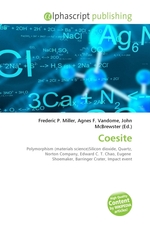Coesite
Frederic P. Miller, Agnes F. Vandome, John McBrewster
бумажная книга
Please note that the content of this book primarily consists of articles available from Wikipedia or other free sources online. Coesite is a form (polymorph) of silicon dioxide SiO2 that is formed when very high pressure (2–3 gigapascals), and moderately high temperature (700 ° C or 1,300 °F), are applied to quartz. Coesite was first synthesized by Loring Coes, Jr., a chemist at the Norton Company, in 1953. In 1960, coesite was found by Edward C. T. Chao[3], in collaboration with Eugene Shoemaker, to naturally occur in the Barringer Crater, which was evidence that the crater must have been formed by an impact. The presence of coesite in unmetamorphosed rocks may be evidence of a meteorite impact event or of an atomic bomb explosion. In metamorphic rocks, coesite commonly is one of the best mineral indicators of metamorphism at very high pressures (UHP, or ultrahigh-pressure metamorphism). Such UHP metamorphic rocks record subduction or continental collisions in which crustal rocks are carried to depths of 70 km or more. Coesite also has been identified in eclogite xenoliths from the mantle of the earth that were carried up by ascending magmas; kimberlite is the most common host of such xenoliths.
Данное издание не является оригинальным. Книга печатается по технологии принт-он-деманд после получения заказа.


